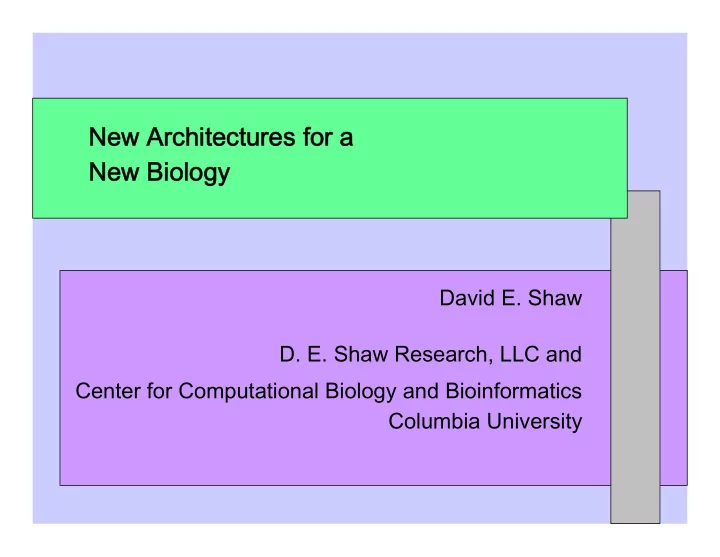

Our Strategy � New architectures – Designing a specialized machine – Enormously parallel architecture – Based on special-purpose ASICs – Dramatically faster for MD, but less flexible – Projected completion: 2008 � New algorithms – Applicable to • Conventional clusters • Our own machine – Scale to very large # of processing elements
Interdisciplinary Lab Computational Chemists and Biologists Computer Scientists and Applied Mathematicians Computer Architects and Engineers
*** New Architectures
Alternative Machine Architectures � Conventional cluster of commodity processors � General-purpose scientific supercomputer � Special-purpose molecular dynamics machine
Conventional Cluster of Commodity Processors � Strengths: – Flexibility – Mass market economies of scale � Limitations – Doesn’t exploit special features of the problem – Communication bottlenecks • Between processor and memory • Among processors – Insufficient arithmetic power
Typical Commodity Microprocessor
Typical Commodity Microprocessor
General-Purpose Scientific Supercomputer � E.g., IBM Blue Gene � More demanding goal than ours – General-purpose scientific supercomputing – Fast for wide range of applications � Strengths: – Flexibility – Ease of programmability � Limitations for MD simulations – Expensive – Still not fast enough for our purposes
Our Special-Purpose MD Machine � Strengths: – Several orders of magnitude faster for MD – Excellent cost/performance characteristics � Limitations: – Not designed for other scientific applications • They’d be difficult to program • Still wouldn’t be especially fast – Limited flexibility
Source of Speedup on Our Machine � Judicious use of arithmetic specialization – Flexibility, programmability only where needed – Elsewhere, hardware tailored for speed • Tables and parameters, but not programmable � Carefully choreographed communication – Data flows to just where it’s needed – Almost never need to access off-chip memory
Two Subsystems on Each ASIC Programmable, � Flexible general-purpose Subsystem Efficient geometric � operations Pairwise point � Specialized interactions Subsystem Enormously parallel �
Where We Use Specialized Hardware Specialized hardware (with tables, parameters) where: Inner loop Simple, regular algorithmic structure Unlikely to change Examples: Electrostatic forces Van der Waals interactions (at least attractive term)
Example: Particle Interaction Pipeline (one of 32)
Array of 32 Particle Interaction Pipelines
Advantages of Particle Interaction Pipelines � Save area that would have been allocated to – Cache – Control logic – Wires � Achieve extremely high arithmetic density � Save time that would have been spent on – Cache misses, – Load/store instructions – Misc. data shuffling
Where We Use Flexible Hardware – Use programmable hardware where: • Algorithm less regular • Smaller % of total time - E.g., local interactions (fewer of them) • More likely to change – Examples: • Bonded interactions • Bond length constraints • Experimentation with - New, short-range force field terms - Alternative integration techniques
Forms of Parallelism in Flexible Subsystem � The Flexible Subsystem exploits three forms of parallelism: – Multi-core parallelism – Instruction-level parallelism – SIMD parallelism
Overview of the Flexible Subsystem GC = Geometry Core (each a VLIW processor)
Geometry Core (one of 8; 64 pipelined lanes/chip) Instruction Memory From PC Tensilica Decode Core X Y Z W X Y Z W Data X X X X X X X X Memory f + + f + + + + + + f f f f f f + +
System-Level Organization � Multiple segments (probably 8 in first machine) � 512 nodes (each with one ASIC) per segment – Organized in an 8 x 8 x 8 toroidal mesh � Topology reflects physical space being simulated: – Three-dimensional nearest neighbor connections – Periodic boundary conditions
3D Torus Network
But Communication is Still a Bottleneck � Scalability limited by inter-chip communication � To execute a single millisecond-scale simulation, – Need a huge number of processing elements – Must dramatically reduce amount of data transferred between these processing elements � Can’t do this without fundamentally new algorithms
*** The NT Algorithm
Range-Limited Pairwise Particle Interactions � Efficient methods known for distant interactions R � Pairwise, non-bonded interactions dominate � Range-limited n -body problem
New Algorithm � Parallel algorithm for range-limited n -body problem � Called the NT (for “Neutral Territory”) Method * � Asymptotically less inter-processor communication than traditional spatial decomposition methods � Constant factors also very attractive – Significant improvements on typical cluster – Major win on large machines * Shaw, J. Comp. Chem. 26, Oct. 2005
Desirable Properties � Ideally, a parallel algorithm for the range-limited n -body problem would: � Exploit the range limitation to reduce computational load � Scale such that data transfer approaches zero as p → ∞
Asymptotic Comparison With Traditional Spatial Decomposition Methods � NT Method has both of these properties: Exploitable Scaling with range number of limitation processors O ( R 3 ) Not Traditional neighbors scalable methods O ( R 3/2 ) O ( P –1/2 ) NT Method neighbors scaling
Partitioning of Space Into Boxes Atom A Home box of atom A
Two-Dimensional Analog of the NT Method Traditional Method NT Method (2D Analog) (2D Analog) Green = interaction box; blue = import region
How can it be better to meet on neutral territory? Traditional Method (2D) NT Method (2D) Number of pairwise interactions (~ product of areas) Number of atoms imported (~ sum of areas):
Actual 3D Algorithm � Considerably more complex – Odd number of dimensions introduces complications � Can be made to work – Math gets more complicated – Performance advantage just as large � Start by describing 3D version of traditional spatial decomposition methods
Traditional 3D Spatial Decomposition Methods
Traditional Spatial Decomposition Method Interaction Box and Import Region Green = Interaction box Blue = Import region
Site of Interaction, Traditional Method � Interact – One atom from (cubical) interaction box – One atom from either interaction box or import region � All interactions occur within home box of one of the two atoms � How much inter-processor communication?
Import Subregion Face(– x )
Recommend
More recommend